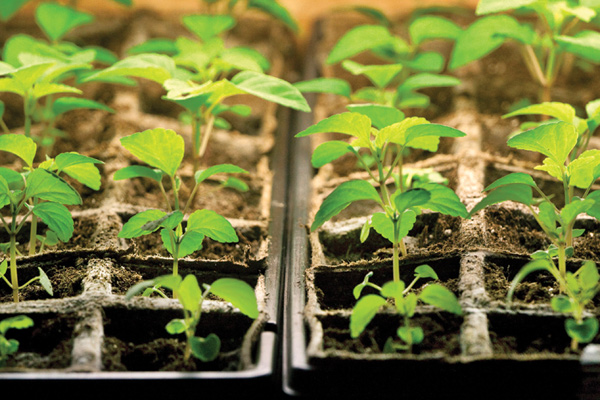PLANTING TIME

By Eric Barrett
OSU Extension Service
For all types of plants, the selection process should consider factors such as ultimate size, adaptability to local soil conditions, exposure to sun, shade, or wind, hardiness (ability to withstand cold, drought, etc.) and maintenance requirements. Consider as well, branching habit, plant texture, foliage color, flowers, and fruit during various times of the year. All this information and more is available from trained landscape architects, extension publications, and professional books. The more one learns about plants, the greater will be the satisfaction gained from the landscape.
Annuals
Annuals are for those areas that are just screaming for some color. They are the best option to provide this color for the entire season. Choose those plants that are not yet in full bloom. If in full bloom, some annuals will respond to pinching. Pinch the blooms back below the bloom to encourage root growth and branching. This is a challenge for anyone who loves gardening. But, in the long run, your plants will be larger and bloom better than anyone else in the neighborhood. Plant spacing is important. Proper spacing will give you healthier plants through the season and maybe save you some money by purchasing fewer plants. At our recent annuals school, Pam Bennett emphasized the importance of plant size. A plant in a bigger pot at the garden center is probably not as expensive as you think, because it is already established and is most likely a high-quality annual, which will add more bang for your buck. Get tips here: http://go.osu.edu/annualplants
Trees and Shrubs
Selection of trees depends on the desired effect and the purpose trees will satisfy in the landscape.
Will they attract birds to the area? Shade a patio? Screen an unsightly view? Enhance the view of the home? Identify an entrance or exit? Trees should provide contrast and relief from surrounding buildings and create seasonal interest in areas near the home.
When selecting a specific tree consider hardiness (ability of the plant to survive extremes of winter cold and summer heat); mature height and spread; growth rate; cleanliness; type of root system; moisture and fertilizer requirements; space available; maintenance requirements; availability; ornamental effects, such as branching habit, texture, and color of bark, flower, fruit and foliage; and whether the tree is evergreen or deciduous.
Susceptibility or resistance to environmental conditions, disease and insect problems may limit your selections. A close analysis of the specific site might also help identify problems. Consider the prior use of the planting site and soil conditions, such as poor drainage, and high or low pH. The presence or absence of channelized winds and the location of utilities both above and below ground are site conditions that dictate plant choice and location. The relationship of the plant to roads, walkways and security lighting should also be considered.
The space available at the specific site and mature tree size are important considerations and addressing these limits will go a long way toward reducing maintenance costs.
The planting diagram shown below represents this graphically. In no instance should trees exceeding 25 feet be planted under overhead power lines. Do not forget the underground utilities. Out of sight does not mean that they would not have to be serviced at some point. Permanent plantings such as trees should be spaced to allow utility service. Ground-level utility structures such as transformers and individual service connections require space to be serviced. A minimum of 10 feet is needed.
Vegetables
You can have a vegetable garden, or you can have vegetables in the landscape. Peppers seem to be a great addition to many landscapes with a colorful array of fruit on the plants.
Also, they don’t require staking. Other vegetables can also be a part of the landscape and still look classy. Choose varieties based on your desires — yield, fresh quality, disease resistance, size and more. Check the website, www.all-americaselections.org.
Perennials
If you don’t want to spend a lot of time and energy watering, choose your perennials now. Don’t wait until the heat of summer arrives.
Look for plant quality when making a purchase. How many stems are coming out of the pot? Is the plant top heavy? What height plant will I need in my garden? These are some of the basic selection criteria. Read the label. It is there for a reason and will give you great details for your chosen plants.
Plan for blooms all season by choosing a group of perennials. The group should have different bloom times so you have blooms in the landscape from early spring until late fall. Make a list of what plants you have and when they bloom. Base new decisions on the “bloomless” times of year you have left.
 43
43

